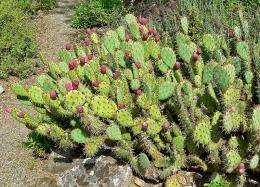April 30, 2010 report
Common cactus could be used to clean water

(PhysOrg.com) -- Access to clean drinking water is lacking in many parts of the world but most technologies to clean water to make it fit for drinking are expensive and hard to maintain. Now researchers propose a cactus common around the world could be used to provide a cheap and easy solution.
The prickly pear cactus (Opuntia ficus-indica) uses mucilage (a gum) to store water internally, and scientists from the University of South Florida in Tampa, led by Dr Norma A. Alcantar, have tested the cactus on water to which they added high levels of sediment and bacteria (Bacillus cereus). They found when the gum is extracted and mixed with dirty water it acts as a flocculant, causing the bacteria and sediments to settle at the bottom of the container, removing 98 percent of the contaminants. They say that boiling a slice of cactus and then adding it to unclean water would provide the cheapest and simplest means of cleaning water in places where other technologies are unavailable or unaffordable.
More research is needed to identify exactly what contaminants are removed, and to provide a means for the users to be sure all bacteria and viruses have been removed. It may also not be a feasible solution for water purification in areas where the prickly pear does not grow, and since it is highly invasive it may not be wise to introduce it if the plant is not already present in an environment.
Alcantar said their next step was to test the cactus on natural supplies of water, but she said the prevalence of the cactus made it an extremely affordable way of purifying water, and the practice would also find cultural acceptance.
The method of using the cactus to purify water was traditional in rural Mexico in the 19th century, but until now no scientific evidence of its effectiveness had been obtained. The cactus is already farmed in Mexico and parts of the US for the pads, which are used as food for livestock and people, and the edible fruits, called “tuna” or “cactus figs”. The sap is also used as a first aid treatment, similar to aloe vera, and the pads can be used for making fibers for baskets and even paper. The prickly pear is native to the US, Mexico and South America, but is now widespread in the Mediterranean and in Africa and Australia, where it has become an invasive weed.
More information: Removal of Sediment and Bacteria from Water Using Green Chemistry, Environ. Sci. Technol., 2010, 44 (9), pp 3514-3519. DOI:10.1021/es9030744
© 2010 PhysOrg.com















